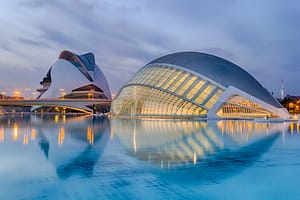Ciudad de las Artes y las Ciencias
Tourists can experience a cutting-edge world of arts and sciences at this futuristic complex on the outskirts of Valencia. The Ciudad de las Artes y las Ciencias is one of Europe’s most impressive centers dedicated to cultural and scientific exhibitions. In a two-kilometer space along the Turia River, the complex includes several stunning examples of avant-garde architecture designed by architects Santiago Calatrava and Félix Candela.
Las Fallas Festival
Every year in March, Valencia becomes a scene of joyous celebration during the Fiesta de San José (Feast Day of Saint Joseph). This lively religious festival is known for its creative installations called fallas, large floats featuring figures made of papier mâché. These creations are set up in the streets and then burned at midnight on the last day of the fiesta. The custom originated in the Middle Ages, when carpenters and other craftsmen would burn leftover scraps of wood and other materials on the feast of Saint Joseph.
Oceanogràfic Valencia
The striking building designed by architect Félix Candela as part of the City of the Arts and Sciences houses the largest aquarium in Europe. It is actually a complex of several buildings, each dedicated to one of the earth’s most important marine ecosystems and environments: Wetlands, Temperate and Tropical, Oceans, Mediterranean, Antarctic, Arctic and Islands, and the Red Sea.
La Lonja de Seda
This magnificent Gothic structure was built in the 15th century to house the city’s Silk Exchange, the marketplace where the famous Valencian silk was traded with merchants (to be sold all over Europe). One of the finest examples of Gothic civil architecture in Europe, the building resembles a medieval castle with its crenellated exterior and formidable tower. The facade features richly decorated doorways, decorative windows, and gargoyles (the grotesque carved creatures that function as waterspouts). The main hall has rich stellar vaulting borne on twisted columns.
Mercado Central
Opposite the Lonja, the Mercado Central is a spacious marketplace built in 1928. The Art Nouveau building is lavishly adorned with azulejos, decorative ceramics typical of the region. The hall contains 1,300 market stalls where vendors sell fresh fruits, vegetables, and food products from the Valencia region as well as other areas of Spain. The Iglesia de los Santos Juanes, a lovely 14th-century church is found immediately next to the market hall.
Parroquia de San Nicolás de Bari y San Pedro Mártir
Perhaps the most ornate of all Valencia’s churches, this church dedicated to St. Nicholas of Bari and St. Peter the Martyr was founded in the 13th century on the site of a Roman sanctuary. It was renovated in the Gothic style in the 15th century, and its interior was finished in the 1690s in the Baroque style. The ornate decorations include gilded carvings and frescoes, which were designed by Antonio Palomino and show the life of Saint Nicholas, one of whose miracles is depicted in a stained glass rose window.
Catedral de Valencia and Plaza de la Virgen
The Cathedral of Valencia is a glorious Gothic church with its emblematic Miguelete Tower soaring above the city. Built on the site of an old Moorish mosque, the cathedral was built in the 13th century and renovated in the 17th century. The exterior combines original Romanesque, Gothic, and Baroque architectural elements. Vibrant azure-hued tiles adorn the domes, which are a distinctive feature of Valencia’s skyline.
Iglesia de Santo Tomás y San Felipe Neri
With its dazzling blue-tiled dome, this beautiful church exemplifies the characteristic Mediterranean style of Valencia. Built in 1725, the Church of Saint Thomas and Saint Philip was listed as a National Historic Monument in 1982. The church has a fancifully decorated Baroque facade, and the architectural layout was modeled after the much-imitated Il Gesú church in Rome. The breathtaking interior has a spacious central nave lined with numerous side chapels. Catholic mass is held at the church daily. The monument is not open to the public for visit, but tourists may attend a mass to see the lovely sanctuary.
Elephants at Bioparc
Valencia’s zoo covers 25 acres north of the park created by the diversion of the River Turia’s course. The landscape was created to house animals in as close to their native habitats as possible, and the zoo is especially known for its large collection of African animals.
The environment is designed so that visitors immediately feel as though they have been transported to Africa as they view animals almost barrier-free in landscapes typical to the savannah, Madagascar, and Equatorial Africa. Instead of separating different species, they coexist as they would in their native environments.
Centre Arqueològic de l’Almoina (Almoina Archaeological Center)
Beneath a sleek modern building across from the cathedral you can step into a world that reaches back two millennia. Discovered during excavations between 1985 and 2005 are well-preserved remains of the first settlement here by the Romans, more than 2,000 years ago. There are remains of baths and other buildings, including a sanctuary, part of the forum portico, and a granary from this and later eras, including the Visigoth and Muslim periods.
Torres de Serranos (Ancient Town Gate)
This impressive landmark is a symbol of Valencia. The Torres de Serranos represents an ancient gate of the Old Town and recalls an era when the town was surrounded by defense walls. The town ramparts were built in the 14th century on top of Roman foundations. In 1930, the Serranos Towers were restored to their former glory. From these massive towers, visitors can take in sweeping views of the cityscape. The archway of the entrance gate features decorative Gothic details and two shields of the city.

